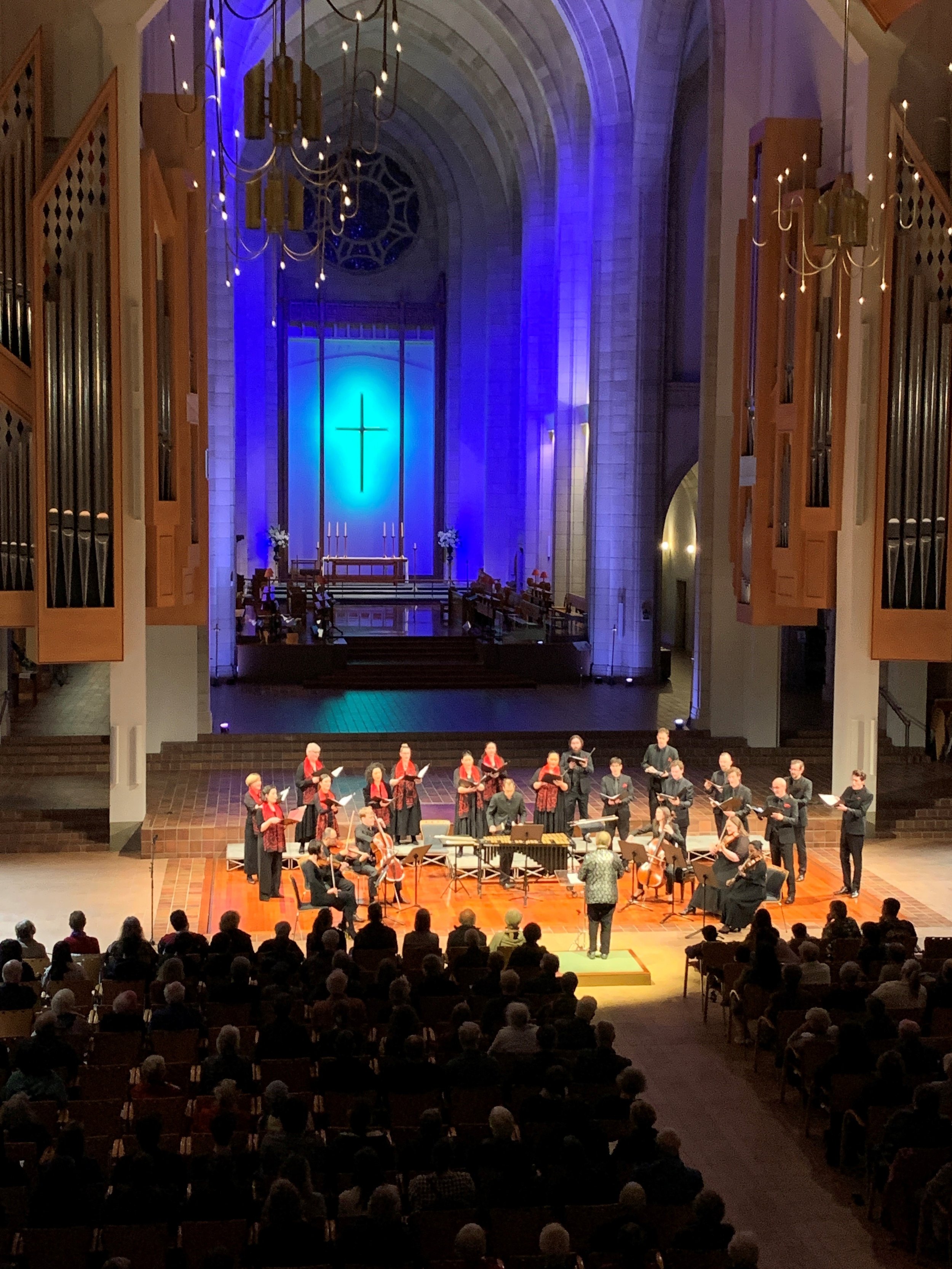Voices New Zealand: Mozart’s Requiem tells a tragic story
Voices New Zealand Chamber Choir, with Music Director Karen Grylls, perform Robert Wiremu’s Mozart Reimagined: Requiem in Holy Trinity Cathedral, Auckland.
The lower slopes of Mt Erebus in the Antarctic in 1979, where 257 people died in a tragic aircraft crash, seem very far from the Vienna of 1791 in which Mozart died, leaving his Requiem in D minor unfinished. But in Mozart Reimagined: Requiem, composer Robert Wiremu (Ngāti Kahungunu, Ngāti Tūwharetoa, Ngāti Porou), music director Karen Grylls and the Voices New Zealand Chamber Choir have brought together times, places and feelings in an astonishing and magical concert, recently toured to six New Zealand cities.
Wiremu's reimagined Requiem uses Mozart’s glorious and familiar music throughout, though not always in the order Mozart intended. Telling the story of the Erebus disaster, Wiremu, singer and composer, uses highly imaginative instrumental and vocal timbres, depicting both the scenes and the anguished emotions of the story.
A cross commemorates lives lost on Mt Erebus, on Ross Island near Antarctica.
There’s no doubt that direct use of Mozart’s music by Wiremu to tell this tragic story is culturally and musically audacious. It would be easy for it to become merely obvious and literal, or perhaps overly and mawkishly sentimental. Making changes to the composition of a master like Mozart could seem presumptuous. Threading Māori concepts through the whole narrative might risk cultural overload.
With great subtlety and imagination these pitfalls are avoided in this profoundly moving work of art which held the audience’s hushed attention throughout.
Composer Robert Wiremu (Ngāti Kahungunu, Ngāti Tūwharetoa, Ngāti Porou)
…telling a tragic story with Mozart’s Requiem, a concert created with subtlety and imagination
Photo credit: Arie Hoeflak
The atmospheric sounds of bowed vibraphone and glissandi on harmonics on string instruments open the Kāranga (the call), evoking birds in empty spaces. Birds also arrive from behind the audience, the whistling singers of Voices New Zealand proceeding one by one down the aisles of St Mary of the Angel's Church in Wellington.
As they arrive onstage, Mozart’s beautiful and reverent Requiem Aeternum is played by vibraphone, the choir responding with lovely singing of the fugal Kyrie Eleison. Voices NZ under the direction of Grylls is a choir very expert in such choral counterpoint and the effect in the church’s resonant acoustic is thrilling.
Music Director Karen Grylls
..leading the choir in a thrilling performance of Mozart’s music.
Photo credit: Charles Brooks
In Rerenga (flight), Wiremu depicts Flight TE901 over Antarctica, using Mozart’s Confutatis, sung first by the ringing tones of fierce male voices with string accompaniment, answered by floating women’s voices with vibraphone. There’s silence – as icebergs come into view, the programme note tells us – and then the full choir, a capella, sings the Sanctus.
As tragedy approaches, the work moves further away from Mozart’s composition. The instrumental music is from the Recordare but all is blurred and confused. With bowed vibraphone and falling string tones and glissandi, Mozart’s music seems to float in from a distant, otherworldly place. Agitated, rough string sounds create a sense of panic and disorder as the singers fall silent. Scattered fragments of Mozart’s music contrast with dramatic chordal moments. Eventually, silence descends completely.
It is broken by the Dies Irae, bravely sung, bursting with rage, the singing ceasing suddenly while the vibraphone continues alone, a ghostly presence, descending and floating. The drama and fury of the Dies Irae returns, a little fragmented, and transforms into an extraordinary evocation of wind over snow as the full choir whispers the Latin text.
Mozart wrote his Requiem at the very end of his life, and was unable to complete it before his death in December 1791. One of the most moving parts is the tragic Lacrimosa, with sobbing appoggiatura and expressive chromaticism. Wiremu sets it for choir and vibraphone as Poroporo (farewell), the singing flowing beautifully, the floating choir seeming a little disembodied, with occasional jarring, discordant punctuation from the vibraphone. I was reminded of the Voices concert earlier this year, “When Light Breaks”, structured around the five stages of grieving, accompanied by the warm resonance of marimba and solo cello. Here percussionist Eric Renick is again providing the musical underpinning, but the metallic vibraphone timbre is a deliberate choice that contributes tellingly to the narrative.
Via Mozart’s Agnus Dei, the work circles back to the Requiem Aeternum and Kyrie that began the concert. The beautiful singing of this Mutunga (completion) is perfectly timed emotionally, even when the final ‘eleison’ stops abruptly. The vibraphone offers musical resolution, and we are taken back to the wheeling birds of the beginning. The visual effect at this point is inspired and subtly achieved – several musicians group around the vibraphone, as if around a coffin, bowing the keys to ethereal effect, the low strings again using harmonic glissandi to evoke the crying of gulls. Choir members stand around the tableau as observers, suggesting mourners, perhaps, at a funeral.
The final section of the programme, Marama (light) is dedicated to singer and Voices member Helen Acheson, who died suddenly just a few months ago. Wiremu has arranged Mozart’s Ave Verum Corpus as a tribute to a beloved friend and colleague of the singers, the tolling of 43 bells throughout the setting representing “every year she shared her light with us.”
It made a deeply affecting conclusion to a moving programme, and when a small child wailed in the audience near the end, it felt as if that crying represented our collective grief. Many in the full house rose to their feet, tears in their eyes, for a standing ovation.
Chamber Music New Zealand ‘Reimagining Mozart’, Voices New Zealand Chamber Choir, Karen Grylls (Music Director), Robert Wiremu (composer). Auckland, Napier, Palmerston North, Christchurch, Nelson, Wellington, October 13-29, 2023.





